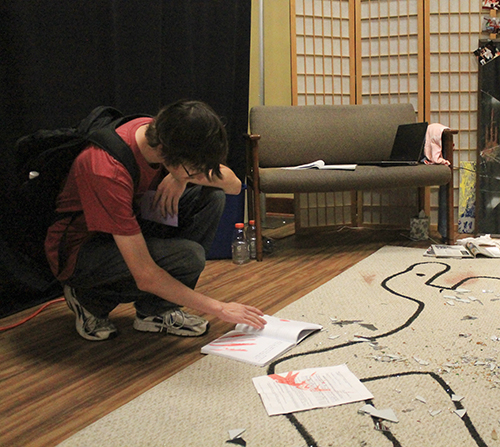
Ryan Baker, sophomore from Murray, reads the last diary entry of the fictional Jenna in the Crazy in Love exhibit.
On average, three women are killed everyday by a current or former intimate partner in America.
This story is a fictional portrayal of a relationship from a walk-through of the Women’s Center exhibit Crazy in Love, although statistics say this kind of scenario plays out every day.
Jenna was great student. She was an active member in a sorority, did well on tests and received multiple scholarships. When she met the love of her life, Chris, it seemed as though everything was working out for her. She would live happily ever after.
During Jenna’s few short months with Chris, she was incredibly happy. He took her out on Valentine’s Day. He surprised her with her favorite flowers and told her how beautiful she was everyday.
After Jenna decided to move in with him and commit her life to Chris, their relationship turned from sweet to sour.
He began controlling who she hung out with and what she wore. He began degrading her body and making her feel worthless. Jenna knew that Chris loved her, so she pushed thoughts of breaking up aside, and instead chalked up his behavior to some mistake on her part.
Chris’s verbal abuse escalated and Jenna’s fear persisted. He left notes on her magazines saying things like, “this girl is so hot, I wish you looked like her” and “you better clean up this house before I get home.”
Each day, Jenna made an excuse for Chris. When he refused to let her see her family on weekends, she told herself that he’s just lonely and he wants to be with her. When he told her she was flirting with other men, she told herself he knew what was best and to trust he loved her despite what he said.
The verbal abuse turned into physical abuse, resulting in Jenna breaking up with Chris. After she thought she was free of his abuse, Chris began stalking Jenna. When she finally had enough and filed a restraining order against Chris, he lashed out and in a fit of rage, stabbing and killing her.
The Murray State Women’s Center put together this story in order to teach students how to spot problems in a potentially abusive relationship and how to stop it before it happens.
Symptoms of abuse in a relationship include:
- Playing with emotions: putting the victim down, calling the partner names, humiliating the victim, making the other partner feel guilty.
- Using male privilege: treating a female partner like a servant, making all decisions, defining men’s and women’s roles in a relationship.
- Using coercion and threats: making or carrying out threats to hurt the partner, threatening to leave or to commit suicide.
- Using intimidation: making the partner afraid, smashing objects, abusing pets, showing weapons.
- Using isolation: controlling what the victim does, who the victim sees and talks to, what the victim reads and where the victim goes, using jealousy to justify actions.
- Visible physical injury and illnesses: bruises lacerations, burns, human bite marks, stress-related illness like headaches, chronic paid, gastrointestinal disorders, sleep disorders and eating disorders.
- Denying, blaming: making light of the abuse, saying the abuse didn’t happen, blaming abusive behavior on drinking or stress, saying the victim caused the abuse.
If someone in a relationship relates to any of the symptoms above, he or she may be in a potentially abusive relationship. If a friend or family member sees any of these symptoms in a relationship, he or she can do the following things to help:
Be a friend. Show that you care for the victim and are willing to listen to him or her.
Guide the victim to a counseling service or center where he or she can talk about the abuse and seek safety from the partner.
Help the victim make a safety plan. Suggest phone numbers the victim can call in case of an emergency and suggest that he or she have an escape plan.
In order to stop abusive relationships and unprecedented deaths, all men and women should be aware of the symptoms of abusive partners and be aware of where to turn if worse comes to worse.
Story by Madison Wepfer, Staff writer